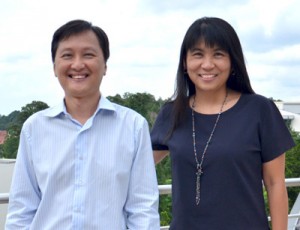Why Singapore’s English Teachers Should Embrace Singlish, Not Fight It
Is it time for Singaporean educators to embrace Singlish as a legitimate learning tool? What the Research […]
Read More
Despite how it sounds, argumentation is not antagonistic! In fact, it drives both students and teachers alike to question and investigate claims they take for granted. This can lead to deeper learning.
To learn is to argue? NIE researchers Drs Tan Aik Ling and Peter Lee certainly think so!
“We’re trying to emphasize that argumentation is not about victory, but about progress,” says Aik Ling. “It is a process to move everybody’s knowledge forward.”
For their research, Aik Ling and Peter are using the pedagogical strategy of argumentation with NIE’s student teachers. This is because they believe that teachers will not be able to implement the practice in their classrooms unless they have experienced it themselves.

Peter Lee (left) and Tan Aik Ling emphasize that argumentation is not about victory, but about progress
In science, it is vital to back up your claims and beliefs with evidence. Argumentation focuses on how students substantiate these claims to make sure they are valid.
“Argumentation is aligned with science communication and inquiry,” Aik Ling explains. “Its structure is a means to help learners think in a logical manner, to be able to frame their answers and discussion in a more coherent, comprehensive and convincing manner.”
To incorporate argumentation in the classroom, Peter and Aik Ling developed tasks that the pre-service teachers can engage in and argue about. To do this, they had to choose topics that were “arguable”, which proved to be quite challenging.
Moreover, in order to argue convincingly, the student teachers need prior knowledge about the topic. Hence, Peter and Aik Ling provided them with resources in the form of an information package.
“The package gave their argumentation depth, even if they started out with low content mastery of the topic,” Peter notes. “When we first started, we gave them access to the Internet, but that wasn’t very helpful. A lot of time is spent searching, reading and making sense of it, which is something they can’t afford to do in a classroom context with time limits.”
Another way of encouraging argumentation is to explicitly teach students the structure of an argument.
“Teaching the student the anatomy of an argument gives them a heightened awareness,” Aik Ling says. “So if you teach your teachers what argumentation looks like, when they are marking, they won’t just say ‘this is wrong’. They will tell the students why it is wrong; perhaps they don’t support their claim, or their evidence is inappropriate.”
It is especially interesting to analyse what people use as evidence. Aik Ling notes that other than traditional sources such as the textbook or Internet, younger children also think of everyday experiences as evidence.
She shares, “Using the same framework, a Primary 4 class was asked to make a shoe while they were studying the properties of materials. They realized then that shoes aren’t made of just one material. One student suggested that rubber can be a good material to make shoes, and when his classmates disputed it, the student countered, ‘How about Crocs! Nobody could argue with that! He didn’t talk about the scientific properties, and yet all his classmates were convinced because they all share the same everyday experiences.”
From there, Aik Ling facilitated their discussion so they could think more critically and support their argument with scientific explanation. Questions such as “What are the scientific properties of rubber which makes it a suitable material for shoes?” can be asked to guide them.
In many cases, argumentation is made complicated because of emotions. It is easier if it is purely an intellectual debate, but being humans, emotions are almost inevitable.
For example, when asked about the controversy about whether the MMR vaccine will lead to autism, the student teachers said, “I believe the scientific evidence that there is no link between the vaccination and autism, but as a parent, I’m still worried.” Or: “Even though my ‘science’ mind tells me this, I will still take the other stand.”
Outside of science, Aik Ling tells us to just take a look at social media. “People have different opinions, right? These opinions generally form part of the argumentation process,” she says.
However, on social media, much of the “evidence” stems from emotions and personal experiences, which can be inaccurate. While everyday experiences are important, Aik Ling stresses that solid and experimental evidence is needed in science to substantiate claims.
Argumentation gives more depth to the learning process, and raises questions that students and teachers alike had no reason to argue about previously. They may even realize that what they learn in the syllabus may not be the best model and there are alternatives out there.
On top of that, to engage in the approach of argumentation, students need good communication skills to explain their reasons for agreeing with or disputing a claim. They also need to be actively engaged in their learning and think critically, and have the ability to sieve out important and relevant information. They should also be willing to share. These are all characteristics of the 21st century competencies.
“The demands on the teachers are challenging, such as taking months to prepare a few good argumentation tasks,” Aik Ling notes.
But as Peter sums it up, “On the other hand, the pedagogy is very much student-focused. It allows students to think in a structured way and question more, which can be applied in many areas of their lives.”